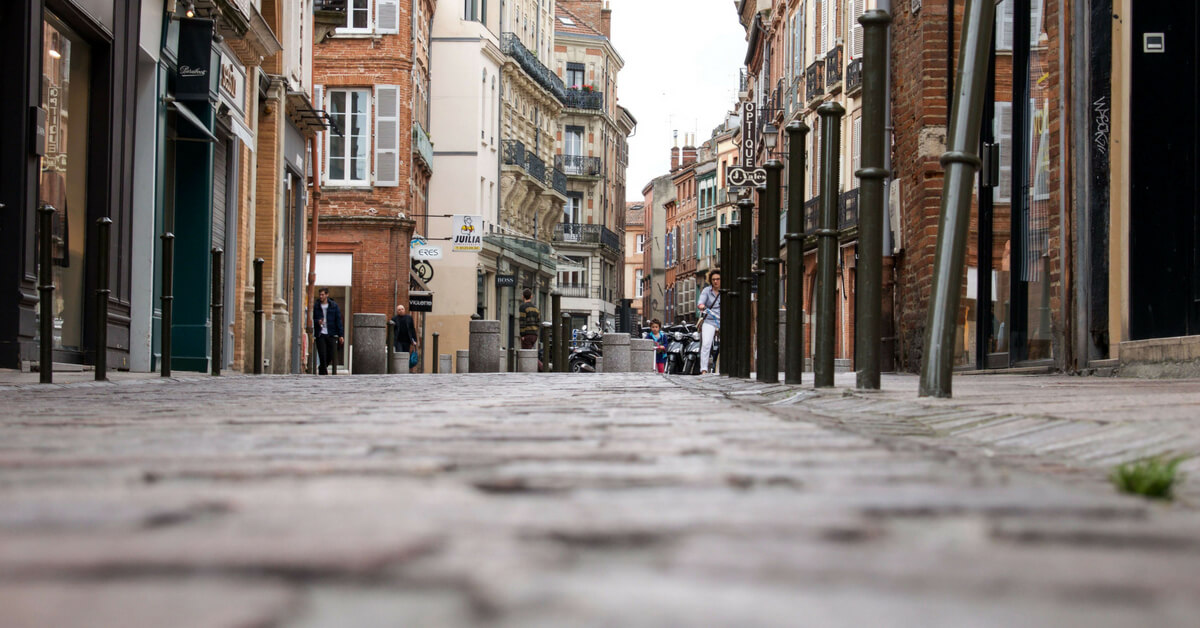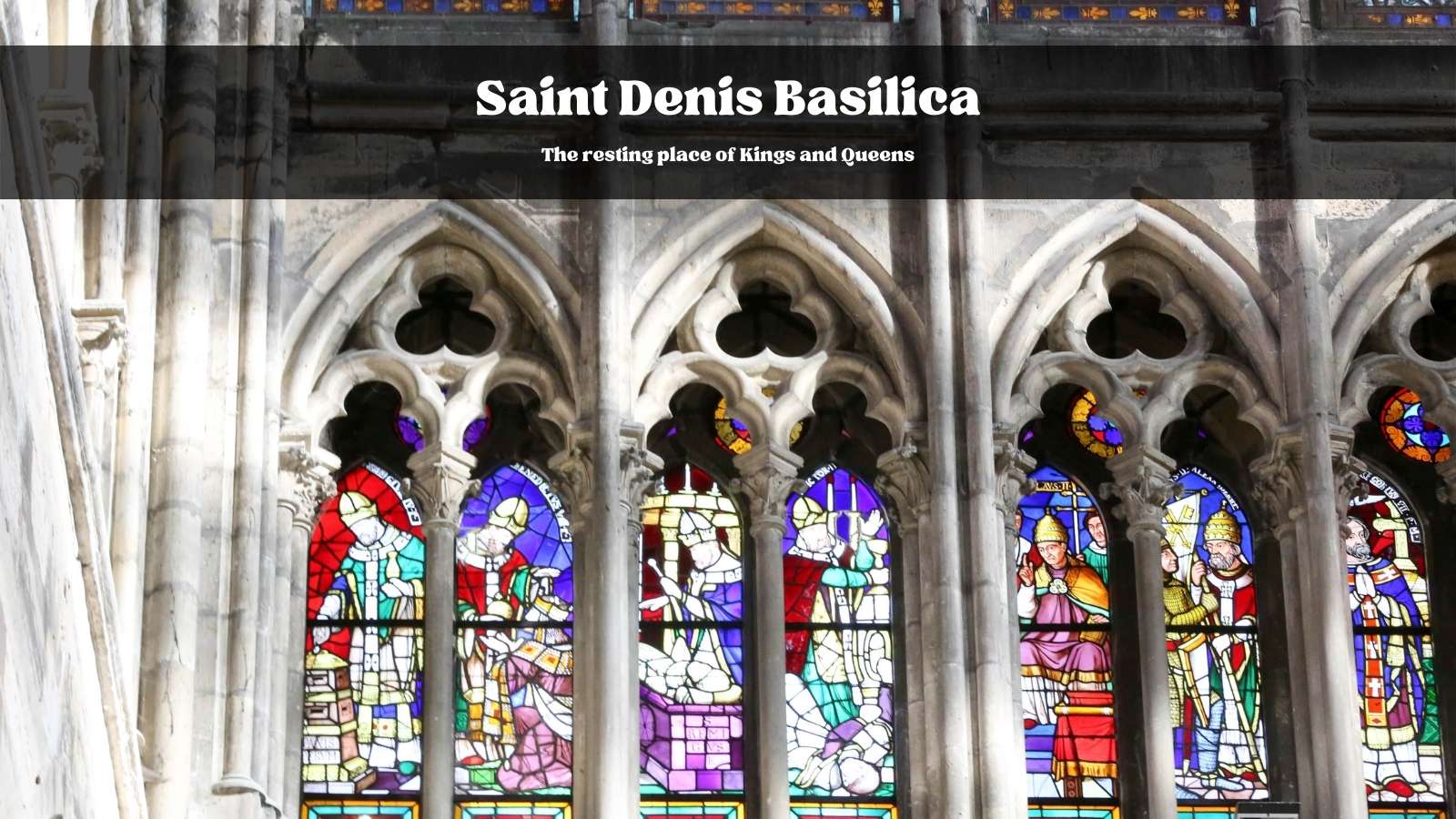Categories: French History, Paris
St. Denis : Abbey and Church
The abbey and church of St Denis are very important in the history of France for two reasons: the complex is intimately connected to the history of the kings of France, and because it is considered to be the first truly gothic structure in the kingdom.
Situated only a couple of miles north of the city line of Paris, the abbey complex is one of the oldest in northern France. It can be reached by taxi, by train, by metro or by car. Please note:
Online timed booking only. 9.5 euros per adult. Open every day but since the basilica is still used as a church, please check online for special closings. Some restoration work is being done in the choir. Check on the official Abbey of St Denis website for more up to date information.
Thousands of visitors go to St Denis every year to see the tombs of some of the famous kings and queens that reigned over the country for centuries. Its history is very well documented, and amazingly, goes back as far as the 200’s (ad) The story begins with Saint Denis who is considered to be the founder of Christianity in France, at a time when the region was still part of the Roman empire.
The legend of St Denis is as follows. Sent to Christianize Roman Gaul sometime in the early 200’s, he arrived with two companions and began preaching. By this time, in the third century, there was growing hostility towards the “new” religion and its preachers for defying the Roman gods. Denis and his companions were killed – that is martyred, sometime close to the year 250, beheaded on the top of the hill that is called to this day, Montmartre (the hill of the martyrs). As the legend goes, he proceeded to walk north, with his head under his arm, until he came to a place called Catolacus, a Roman settlement, where he finally died and was buried. A small church was built in his honor and his remains were buried under that church. The cult of Denis began there.
By the 400’s when Christianity had become an official religion, as the Merovingian kings had converted, not only was the city named after St Denis, (he had become a saint by then) but the Frankish king Clovis, the first to consolidate the region to create a sort of country, declared the burial site of St Denis to be Ad Sanctos. That is, a holy site next to which it was a privilege to be buried.
And so began a tradition that lasted for 1300 years, of having the ruling families: kings, queens, princes, and close family, buried as close to St Denis as possible.
In 650, the king Dagobert enlarged the small church and monastery and made it a part of the Benedictine abbey system.
Again, in the 770’s it was enlarged even more, chapels were added and it took on the form of a Roman basilica: it was redesigned in a circular form (like in Rome) and some vestiges of roman marble and columns were even re-used in its new building. It became even more of a special privileged church due to having important saints and relics buried there. This also became the prestigious religious institution where the king’s sons were educated.
In the 800’s, Paris and its surrounding region were sacked several times by the marauding Vikings, who would come up the rivers, plunder, and destroy much of what they found. St Denis was not spared this disaster, and many of the buildings were destroyed. At the end of the 800’s when the raids stopped, it was decided to build fortress type walls around the abbey and church to protect them. And it was at this time that the abbey complex became a major pilgrimage site and took on even greater importance.
And so, for centuries, St Denis remained the holy burial place of the saint St Denis and the dynasties of the French kings. And that takes us up to the 1100’s. By this time, the beginning of the 12th century, France is a rich and important nation in Europe. There are major advances in architecture, and there is a certain general prosperity.
The Beginning of Gothic Architecture
The head of the abbey of St Denis in the 1100’s is a man named Abbott Suger. He was both the head of the abbey and counselor to the kings, Louis VI and Louis VII. Cultivated, rich, and ambitious, he had a great desire to renovate and “modernize” the abbey and church of which he was the leader. In order to do so, he needed the approval and money of the kings. Abbott Suger had a plan and, to use an expression of today, he ‘saw big!’. He had seen that in Normandy there were a few monastery churches that were starting to raise the walls higher, using a new concept, the broken arch. This allowed for more space for windows.
Suger, as a theologian and very influential man, wrote a thesis on what a church should look like and feel like on the inside. And in this thesis, he said that there needed to be more light, more color, that the inside of the church needed to be flooded with light, because it represented the divine spirit.
So, unlike the very austere monastic churches of before, he worked with builders and stone masons to design a “new” church that would have less wall and more window. And in order to have the light coming in through the windows be “celestial” rather than just too strong and bright, he pushed the glass makers to use as much color as possible. In doing so, he created the very first of the wonderful tall gothic windows with colored stained glass, that have come to represent the cathedrals of France.
By 1144 there were 14 windows in the choir of the church, two for each bay. Many told stories from the bible. These windows cost more than all the rest of the construction of the church because glass was precious and very expensive to make!
In 1171 the new church of St Denis was finished, the very first Gothic church; filled with color and light. St Denis was also the first church to have what is called a “rose window”, the beautiful round window set in the transept part of the church, filled with thousands of pieces of stained glass.
But believe it or not, in the 1200’s the windows of St Denis were redone! By this time the techniques for making stained glass had become much more sophisticated: (Notre Dame and some other major cathedrals were in the process of being built too) The church and abbey of St Denis were famous and very special, both for the tombs of the royal families buried there, and for the gorgeous stained-glass windows in the church which were the inspiration for all the others: Chartres, Reims, Notre-Dame…
And all through these centuries, the kings and their immediate families were buried in the ground of the abbey of St Denis. Four major dynasties of kings and queens were there. That is, up until the French Revolution.
The French Revolution and Today
Starting in 1793, the basilica and the abbey of St Denis were trashed. Tombs were destroyed or mutilated. The treasures were taken away, to be sold or melted down to make bullets and cannons. The stained-glass windows were almost all destroyed and then the final disgrace; in 1794 most of the other windows were dismantled as was the roof, so that the lead surrounding the little pieces of glass could be melted down and turned into bullets. All in all, the tombs of 42 kings, 32 queens, 63 princes and 30 abbotts were completely destroyed. Their remains were taken out of the coffins, put together in a huge open pit, and covered with lye to be dissolved!
In the early 1800’s, once the Revolution had receded and there was a return to calm, an attempt was made to recover the remains of some of the kings and queens. But it was impossible to know who was whom, so several commemorative slab tombs were made, with whatever remains could be recuperated, and with a list of the names of the kings and queens carved on top of them.
Napoleon wanted to rebuild St Denis, as it was important for him as a symbol of the continuity of power. He even had plans to add a new wing for what he imagined would be the “next” dynasty of kings, his own family! But finally, it was under the auspices of Louis XVIII, the last surviving member of the Bourbon dynasty, that much of the abbey and church started to be rebuilt. And it was this same king, Louis the XVIII, who became, in 1824, the last king to be buried in St Denis.
At first it was the roof of the abbey church and some parts of the monastic buildings that were restored as much as possible. But finally it was Viollet le Duc, in the mid 1850’s, who was responsible for the major work to restore the church and abbey to its former structure. Much of what we see now when we go there is the work of the architects and artisans from the 1850’s and 1860’s. They reproduced the majority of the stained-glass windows. Only five of the original 14 gothic windows are still there, mixed together with the “newer” glass.
The sculpted crypts and flat tombs we can see are all pieces that were redone in the 19th century too. The most important being the room with the Bourbon kings and queens as they were the last of the great dynasties (Louis XIV, Louis XV, Louis XVI).
What was mostly saved and restored to its original form however is the western façade with its three large portals and late Romanesque arches. The central doorway’s sculpture has as a theme the Last Judgment, the left side tells the story of St Denis and his companions, and the right-side portal is dedicated to the last rites, and the communion.
Even more revealing and fascinating is that because of all of the destruction and rebuilding done in the 19th century, several of the earliest parts of the original church, dating back to the 500’s, have been uncovered! And in 1959, a tomb was found that has become very important for medieval archeological purposes. It turns out to be the tomb of a queen named Arégonde, one of the wives of the very early Frankish king Clotaire I, son of Clovis. To the astonishment of the archeologists, the entire contents of the tomb were intact when it was opened; her skeleton, her clothes, her jewelry and some writing that indicated who she was and when she died. (c.575) All of her very beautiful and elaborate jewelry is now in the archeology museum of St Germain en Laye. And this tomb is, to this day, the best preserved and best documented tomb from the early Middle Ages found anywhere in western Europe!
So going to St Denis today is a voyage back through history. Even with much of it being replicas or restoration, it is still incredibly beautiful.
And walking through the rooms with the sculpted tombs of many kings and queens, carved in white marble, is an impressive journey back through time to the beginning of the history of France. It shows how much continuity there has been in this, the oldest unified country in Europe.
Subscribe to the Podcast
Apple Google Spotify RSSSupport the Show
Tip Your Guides Extras Patreon Audio ToursRead more about this show-notes
Episode Page TranscriptCategories: French History, Paris


